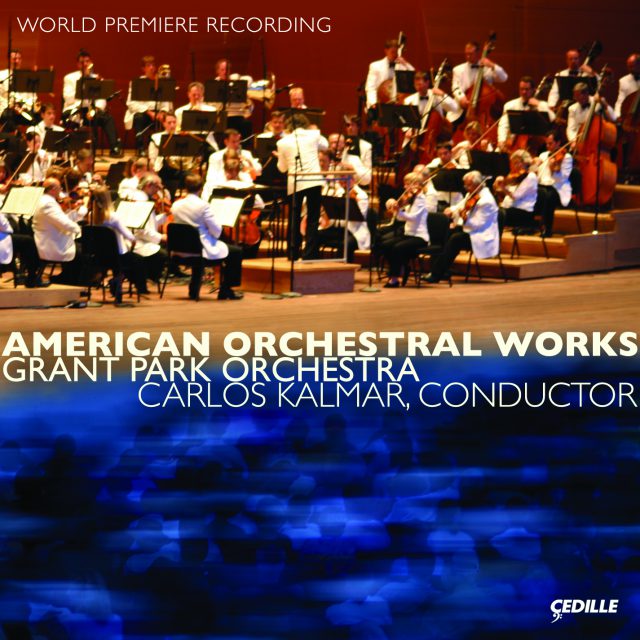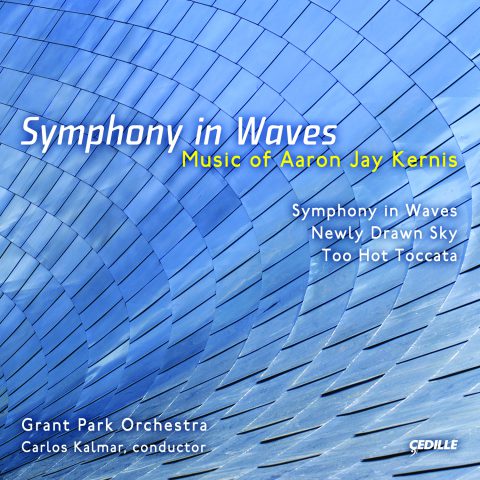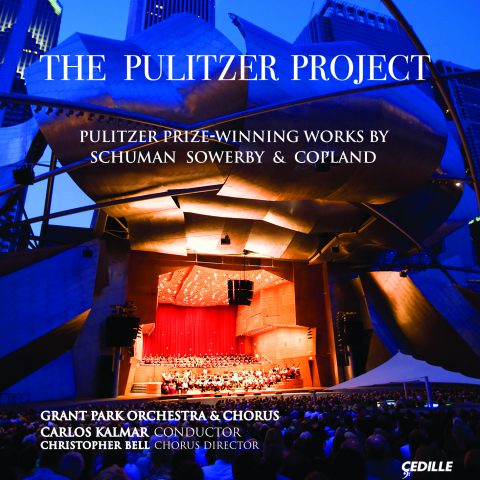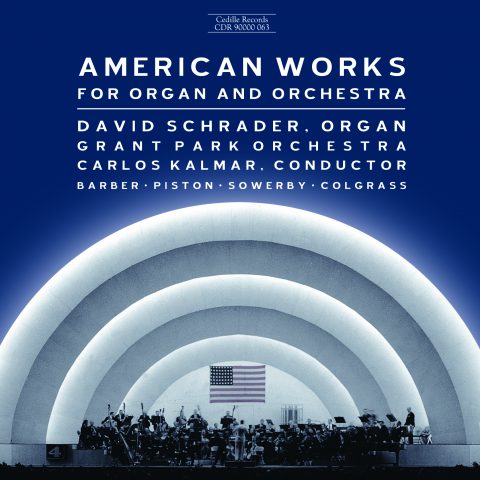Store

Cedille Records’ recordings of American music with the Grant Park Orchestra (ensemble in residence for Chicago’s summer Grant Park Music Festival) and principal conductor Carlos Kalmar have garnered raves and awards for their spirited performances and spectacular sound.
Their newest CD, American Orchestral Works contains world-premiere recordings of music by three generations of contemporary composers, some well established, others poised for greatness.
Featured are Barbara Kolb’s propulsive All in Good Time (1993), Aaron Jay Kernis’s richly chromatic Sarabanda in Memoriam (2003), Michael Hersch’s powerful Ashes of Memory (1999), John Corigliano’s celebratory Midsummer Fanfare (2004), and John Harbison’s masterfully crafted Partita for Orchestra (2000).
Recorded in the new, acoustically superb Harris Theater for Music and Dance in Chicago’s Millennium Park, Cedille’s vibrant American Orchestral Works is not your typical summer fest fare.
Preview Excerpts
BARBARA KOLB (b. 1939)
AARON JAY KERNIS (b. 1960)
MICHAEL HERSCH (b. 1971)
Ashes of Memory
JOHN CORIGLIANO (b. 1938)
JOHN HARBISON (b. 1938)
Partita for Orchestra (2000)
Artists
Program Notes
Download Album BookletAmerican Orchestral Works
Notes by Andrea Lamoreaux
Barbara Kolb’s All in Good Time was commissioned by the Philharmonic-Symphony Society of New York as part of the New York Philharmonic’s 150th-anniversary celebration, and was first performed in 1994. A major clue to the nature of All in Good Time comes at the very top of the score: the opening tempo indication is Preciso, precise or exact. Permutations of rhythm are at the heart of this short, intense composition, which is bookended with passages so squarely, rhythmically regular they almost march. In between comes a section where rhythm — and therefore musical time — seems to stop altogether. “All in Good Time,” the composer writes, “presents a vision of rhythmic development, and thereby a personal expression of the movement of time itself.”
Kolb has written extensively for orchestra and has a profound understanding of the colors of the symphonic palette. She uses these to striking advantage in All in Good Time, but her principal interest is in building the intensity of repeated rhythmic figures up to a climax, after which everything stops, only to resume with even greater intensity, ending in a coda of driving momentum. A flamboyant opening gesture comes from the wind instruments topped by the glockenspiel (the bells of the percussion section). Low strings then begin a pattern of repeated figures, or “ostinato,” that build continuously. The orchestra’s higher voices gradually join in, presenting fragmentary themes that remain subservient to the rhythmic interest. As instruments are added the sound level increases. The ongoing crescendo is then highlighted by scurrying up-and-down motives in the winds. A trombone motive emerges next from the full orchestral texture, leading to a climax and a sudden stop.
A solo saxophone, accompanied by vibraphone, begins a free-form passage with no discernable rhythmic pulse whatsoever. Soon enriched by bass clarinet and pianissimo strings, this central passage is marked “Relaxed, as in an improvisation: Bluesy.” Time stops amid a shimmer of peaceful, quiet sonority. Succeeding the saxophone solo is a lengthy solo passage for wood block, supported by bass drum and low strings, moving in a free pattern that echoes the sax solo rhythmically, but with an entirely different tone color. The pulsing rhythm in the low strings gradually returns for a recapitulation of the opening section, varied and enriched with more expansive themes. The brass is more prominent, but what we continue to hear most strongly are the strings, whose figures gradually coalesce on one note. Snare drum and glockenspiel figures decorate this obsessive coda, which resolves the piece into a distinctly contemporary example of that favorite 18th-century key: D Major.
Aaron Jay Kernis’s Sarabanda in Memoriam was commissioned for New York’s Orchestra of St. Luke’s and premiered in 2004. It is based on the second movement of Kernis’s String Quartet No. 2, originally commissioned for the Lark Quartet.
Both of Kernis’s string quartets were premiered by the Lark Quartet, and the second won him the 1998 Pulitzer Prize for music. Kernis noted that the piece’s subtitle, “Musica Instrumentalis” had been used by Renaissance and Baroque composers to describe a dance suite: “I have been playing various suites of Bach’s and pieces from the Fitzwilliam Virginal Book at the piano for my own pleasure for years, and I think I’d suspected for some time that their influence would eventually show up in my work.” The early music he was exploring on the piano was based largely on ancient, traditional dance rhythms, and had titles such as Allemande (German Dance), Corrente (fast Italian dance), Gigue (Jig), Musette, Gavotte, Minuet, and Sarabande. Bach and his contemporaries strung such dance-derived pieces into suites for keyboard and for chamber orchestra. Later composers have reused and reinterpreted the idea, including John Harbison in his Partita for Orchestra. For his Second String Quartet, Kernis constructed a three-movement work that incorporates modern incarnations of any number of older patterns.
At the turn of the 21st century, at the age of 40, Kernis had garnered a number of important awards and commissions. He was then, as now, a leading American composer of outstanding creativity and originality.
But a brutal interruption, for him as for us all, occurred on September 11, 2001.
I could not hear music in my head for many weeks after… nor did I have any desire to. [The] images from that day have not faded, they’ve simply been replaced with images of life so that it would be possible to continue on, and the sounds, the crashes, the rain of fire, the smoke that I could see… have since been crowded out to allow room for music again…. I did not know what to feel then, nor do I now. Sounds gradually returned to me, and when empathy and emotion began to displace the lack of feeling, [I recalled] the last elegy I’d written… from my Second String Quartet… dedicated to the memory of Bette Snapp, who died during the composition of [its] second movement. She had been a friend and supporter to me and countless other composers.
The string quartet movement that had evolved as a private memorial was expanded for string orchestra to forge a different statement of mourning: “Though the muisc in this new version is virtually the same as in the original, [it] is more public in its sonic mass and scope, now a memorial for far too many victims.”
The quartet’s original movement was called Sarabande Double, Sarabande Simple. For the string-orchestra version, this became Sarabanda in Memoriam. A sarabande was originally a slow dance in triple meter. This description might recall the nature of a waltz, but there’s really no similarity: light-hearted romanticism is far removed from the solemn, formal, courtly nature of the original sarabande. By the time of the late Baroque, the word “sarabande” had taken on the meaning of a slow, reflective, sometimes grief-stricken interlude separating livelier dance movements. Since the Baroque, the term has become completely removed from the realm of dancing. Derived very distantly from a dance form, it’s reinvented here as a state of mind and heart with strong emotional overtones.
The sarabande themes emerge at a slow tempo marked “Poco Adagio.” These are contrasted with faster passages that are often quite dissonant, and, in the full string-orchestra version at least, express anger and horror: sometimes they even sound like screams. These sections are alternated with the strongly lyrical sarabande portions, which combine intense grief with serene contemplation. Kernis makes full use of the resources of his string orchestra, often dividing sections (e.g., second violins, violas) into two parts to present thematic material in tandem or in counterpoint. This imparts a rich texture, punctuated on numerous occasions by solo voices within the string sections. Most of the progressions are linear, with much contrapuntal interaction, but about two-thirds of the way through the piece, a powerful unison passage brings all the voices together in an outburst that communicates fist-shaking rage. Succeeding this is a poignant cello solo, with a theme soon joined and supported by other low strings. Then the entire orchestra is back with a recapitulation and intertwining of previous motivic threads. Solo voices become prominent again as Sarabanda in Memoriam slows down to a moving conclusion of sustained grief.
Michael Hersch’s Ashes of Memory was commissioned by Mariss Jansons and the Pittsburgh Symphony Orchestra and first performed in 2000.
The youngest composer represented on this CD has risen to major prominence as he approaches his 35th birthday. Michael Hersch has been recognized with the American Composers Award, a Guggenheim Fellowship, the 2000 Rome Prize, and the 2001 Berlin Prize. A graduate of Baltimore’s Peabody Conservatory, where he now teaches, Mr. Hersch didn’t come into contact with concert music until his late teens. He followed his two Peabody degrees with advanced studies at the Moscow Conservatory. Increasingly well known throughout the United States, his orchestral and chamber music has also been performed extensively in Germany. This CD represents the first commercial recording of any of his symphonic scores. But Ashes of Memory has traveled widely in concert: After its Pittsburgh premiere, it was performed in Atlanta, Seattle, and Cincinnati; at the Grant Park Music Festival in Chicago; and in European concert venues as well.
The composer describes the two-movement work as follows:
It commences with quiet clusters in the strings over a pulsing figure heard in the timpani. The harmonic, melodic, and rhythmic figurations set forth in the work’s opening pages are the building blocks for the entire piece. The early moments of the first movement continue on with interspersed intrusions of ever-increasing intensity before reaching a sustained Allegro that spans almost the entire movement. The coda of the Allegro is suddenly cut off, yielding to an epilogue in which the harp, a few solo strings, winds and ultimately the piano and low strings bring the movement to a close. The second movement begins and continues on with a pedal figure heard in the cellos and basses. Ultimately, no matter how much rhythmic or contrapuntal activity is occurring above… this repeated figure never ceases. In addition to the pedal figure, three primary ingredients stemming from materials heard in the first movement make up the framework for the second movement: all of the second movement’s development is centered around a return to the first-movement Allegro. The first [ingredient] is the [sequence of] punctuated strikes of the piano and harp at the beginning of the movement. The second is a theme in sevenths and ninths, heard in the violas, which continues on with the addition of cellos, bassoons, and bass clarinet. The third [ingredient] is a more expansive theme heard initially only in the violas, accompanied by a hovering timpani figure.
These elements combine and build to a conclusion, which, the composer says, “should feel akin to a light being slowly extinguished.” (He also notes that in this performance, the second movement tempo is faster than what is marked in the score.)
The dominant voices throughout the piece are those of the timpani in the first movement, which set everything into motion, and the low strings in the second movement, whose presence permeates the entire texture. Percussion instruments are prominent throughout. For Mr. Hersch, the work seems to incorporate fragments of earlier pieces and earlier experiences that have persisted in time and memory. This sense of ongoing recollection is the source of the work’s title.
John Corigliano’s Midsummer Fanfare was commissioned by the Grant Park Music Festival for the 2004 opening of Pritzker Pavilion at Millennium Park.
The 2004 Grant Park Music Festival was even more vibrant than usual, as the City of Chicago at last opened Millennium Park and the orchestra found its new home in Pritzker Pavilion. This venue for the nation’s only remaining free, outdoor, classical-music summer festival features state-of-the-art acoustics on the shores of Lake Michigan, with the Chicago skyline providing a magnificent backdrop. The opening of Pritzker called for celebratory music, which John Corigliano duly provided with his Midsummer Fanfare. A major American composer, New York-based like so many of his colleagues, Corigliano spent significant time in Chicago as the Chicago Symphony Orchestra’s composer-in-residence in the late 1980s and as the Grant Park Music Festival’s principal composer for 2004. He describes Midsummer as an introduction and fanfare. The introduction is diffuse at first, “slowly [building] in both tension and texture until, by its end, the sound is wild and frenzied, pulsing with blurring energy.” Throughout this development, fragments of the eventual fanfare are hinted at. After a big climax, the brass instruments — horns, trombones, finally trumpets — bring forth the fanfare proper: majestic and affirmative. There’s a short recapitulation of all of the thematic threads before the piece comes to its upbeat conclusion: a brilliant flourish for the city’s celebration. (Premiered outdoors at the 2004 Grant Park Music Festival, Corigliano’s Fanfare was repeated indoors at the 2005 Festival — the performances from which this recording was made.)
John Harbison’s Partita for Orchestra was commissioned by the Minnesota Orchestra for its centennial and was completed in December 2000.
Devotees of contemporary American music know John Harbison for his genius in combining sonorities, themes, and rhythms into new and engaging structures that express clear emotions and purposes. This artistic straightforwardness, however, doesn’t mean that he dislikes playing games. The Italian word “Partita” means game, although the term was adopted centuries ago, at first to mean a set of variations on (or games with) a theme, then a suite of dance-inspired movements, then later (around Haydn’s time) a set of short pieces for wind ensemble. In his Partita for Orchestra, Harbison combines the game meaning with the dance-suite meaning, titling and informing the work’s four movements with elements that recall the Baroque era. He also considers the work a concerto for orchestra, spotlighting the virtuosity of each symphonic section as the piece unfolds. The titles of the four movements give clues to the melodic and rhythmic progressions, and to the piece’s highly-contrasted moods.
The first movement is titled Prelude–Fantasia. In the 17th and 18th centuries, a prelude was a free-form introduction to a more structured piece, such as a fugue, which has lots of rules for its unfolding. But a prelude can also be a stately introduction, and this one starts with brass flourishes that certainly get our attention. The fantasia element comes in with the emergence of isolated, evanescent motives scattered throughout the ensemble: here a wind sound, there some spotlighted strings, etc. This leads to a lyrical, wandering, improvisatory passage for the full string section, eventually counterpointed by a trumpet solo. The isolated motives return, leading to a full orchestra climax that winds down to a subdued ending.
The brief second movement, Rondo–Capriccio, is playful: truly capricious in the introduction and re-introduction of its scurrying rondo theme, which is punctuated by slower passages that suddenly leap up again into frenzy, with much decoration from the percussion section. With the next movement, the mood changes completely. Harbison writes that the Aria–Sarabande movement “seems to be about the difficulty of singing.” The string sound in this slow movement is lyrical but hesitant; the high strings’ song is contrasted, echoed, and even challenged by progressions in the low strings with bassoons and horns complementing. The sound gradually intensifies and enriches as the aria becomes more confident and assertive. The mood is slightly elegiac, recalling the original solemnity of the ancient Sarabande. Toward the end of the movement, the brass section makes a statement that’s brilliant but feels intrusive, seeming to intimidate the string song as it retreats to a hesitant conclusion.
The Partita’s denoument is anything but hesitant, however: Harbison seems to be saying, “Well, if you can’t sing you can dance.” The Courante–Gigue finale is a high-stepping dance that combines lively rhythmic patterns derived from the styles of the 17th-century French courante and gigue (or jig in English). Syncopated progressions in the brass and wind sections are punctuated by prominent percussion. These are then joined by rapid string figurations. The pace slows briefly, and the orchestral tone becomes more declamatory, but the dance element is never really absent, as Harbison’s engaging musical game builds to an upbeat conclusion.
Andrea Lamoreaux is music director of WFMT-FM, Chicago’s classical-music station.
Album Details
Total Time: 76:00
Producer: James Ginsburg
Engineer: Eric Arunas and Bill Maylone
Recorded “Live” in Concert: July 1 & 2, 2004 (Kolb, Kernis, Hersch) and July 1 & 2, 2005 (Corigliano, Harbison) at the Harris Theater for Music and Dance, Millennium Park, Chicago
Graphic Design: Melanie Germond, Pete Goldlust
Front Cover Photo: The Grant Park Orchestra performing in the Jay Pritzker Pavilionin Chicago’s Millennium Park © Kosta Trimovski
©2006 Cedille Records/Cedille Chicago
CDR 90000 090



